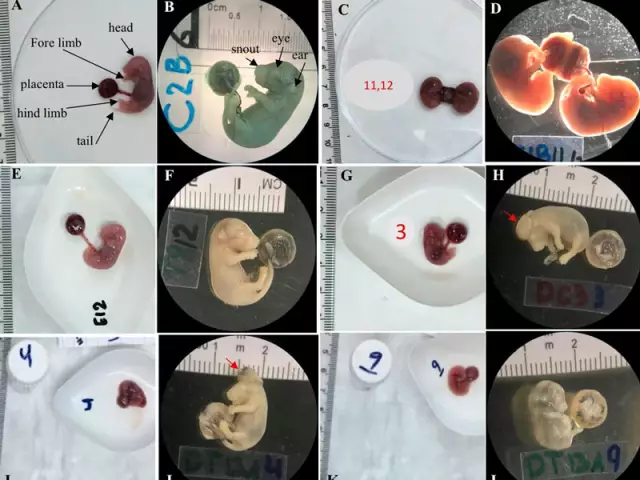- Author Rachel Wainwright [email protected].
- Public 2023-12-15 07:39.
- Last modified 2025-11-02 20:14.
The reasons for the development of congenital anomalies, or teratogenic factors

Congenital anomalies are a group of pathologies that form in the most vulnerable period of human development - intrauterine. This is a period of complete helplessness, vulnerability of the unborn child, and therefore a high responsibility of the mother. The scale of the development of the defect is in direct proportion to the exact time the fetus was damaged - the earlier, the more severe the pathology. In ancient times, it was believed that children with congenital anomalies were born due to the fact that a pregnant woman was negatively influenced from the outside - they talked about the evil eye, "fright", witchcraft and other mysterious, and therefore twice as terrible things. Of course, today such explanations cannot be considered seriously, but the ancients were not mistaken in one thing: the cause of congenital anomalies often lies in the pathological processes in the body of a pregnant woman,arising under the influence of some damaging factors, however, not always external. Such factors are called teratogenic (from the ancient Greek teratos - monster, freak).
Stages of fetal vulnerability
The fetus at different periods of its development has a different sensitivity to damage; in total, doctors distinguish three periods of vulnerability during pregnancy.
The first period, "all or nothing".
The smaller the embryo, the more vulnerable it is, and if a large number of cells of the embryo are damaged, it dies, resulting in a spontaneous abortion, or miscarriage. It is interesting that if an uncritical part of the cells dies at this earliest period, then the survivors will be able to compensate for the loss without further damage to the body, since the cells are not yet differentiated. Doctors call this "all or nothing" reaction, and it happens from the first hours of pregnancy to 18 days.
The second period is the most vulnerable.
Damage received during the period from 18 to 60 days of pregnancy can also lead to the death of the fetus, but if it survives, the damage will no longer be completely restored, since the cells differentiate at this time, that is, acquire differences inherent in one or another tissue. In this case, the child will be born with severe abnormalities, some of which may lead to his non-viability after birth, but not necessarily. The most severe malformations are laid in the period from 18 to 36 days of pregnancy, later they are less severe. For this reason, the gestation period from the beginning to 3 months (the period is taken in excess, since in a natural pregnancy it is quite difficult to establish the period with an accuracy of one day) is considered critical, during this period the fetus is especially vulnerable, and therefore the woman is advised to avoid exposure to any teratogenic factors.
The third period is the period of the formed fetus.
At these times, the formation of fetal organs and systems has already been completed, and therefore they can no longer develop incorrectly. However, the influence of negative factors can lead to impaired growth of the fetus, death of part of its cells, deterioration of the work of any organ or organ system. The child's delicate nervous system is especially vulnerable at this time.
Main teratogenic factors
Teratogenic factors can be chemical, physical, biological. In order for any factor of influence to be recognized as teratogenic, it is necessary to convincingly prove the connection between the effect of any factor and the appearance of a violation in the development of the fetus. All factors leading to the appearance of congenital malformations are divided into four main groups:
- Chemical substances;
- Physical factors (ionizing radiation);
- Infectious agents;
- Errors on the part of the pregnant woman herself: internal (diseases) and external (the presence of bad habits, the wrong lifestyle).
Of the infections, viruses have the greatest teratogenicity, namely cytomegalovirus, herpes simplex virus, toxoplasmosis virus, rubella, parvovirus. Also, high teratogenicity is inherent in pale treponema, the causative agent of syphilis.

A lot has been known about the pathogenic effect of ionizing radiation for a long time, and already, probably, everyone knows that pregnant women need to try to avoid it in any form. Fortunately, in everyday life, people rarely encounter this factor.
Chemical factors include mercury vapors, toluene, chlordiphenyl and substances derived from it, as well as a fairly large group of drugs. Paracelsus also said that everything is poison and all medicine, and any pharmacist will confirm that all medicines in large doses are poisons. Therefore, the general rule is as follows: during the period of teratogenic vulnerability, it is advisable not to take any medications at all, and it is categorically impossible to take them without an urgent need, confirmed by a doctor. Throughout pregnancy, you should also try not to take medications, but if, nevertheless, a woman is forced to do this, it is imperative to consult a doctor, and while undergoing treatment for any disease, the attending physician must be informed about her situation.
List of drugs with the most significant teratogenic effect:
- Antibiotics of the tetracycline series (tetracyclines);
- Busulfan;
- Valproic acid;
- Warfarin;
- Hormones and hormone-like androgenic agents;
- Diethylstilbestrol;
- Isotretinoin;
- Iodides (iodine compounds);
- Captopril;
- Lithium carbonate;
- Methotrexate;
- Penicillamine;
- Thalidomide;
- Thiamazole;
- Trimethadione;
- Enalapril;
- Etretinate;
- Phenytoin;
- Cyclophosphamide.
What in the health of a pregnant woman can lead to congenital pathology
There are diseases, in the presence of which the expectant mother has a high risk of giving birth to a sick child or a child with congenital malformations. These are, as a rule, systemic diseases caused by metabolic disorders, or causing it. Such diseases include endemic goiter, diabetes mellitus in the stage of decompensation, phenylketonuria, tumors that stimulate the secretion of androgenic hormones. Folic acid deficiency, prolonged hyperthermia (overheating) can also become teratogenic factors.
Talking about the factors causing damage to the fetus during intrauterine development, one cannot ignore bad habits. Smoking, alcoholism and the use of narcotic drugs in any case have a bad effect on health, but in pregnant women they can lead to irreparable and serious consequences. Is a glass of alcohol or a puff of a cigarette worth a life full of torment for another person and those who will surround him? In this case, the price of a foolish whim may be too high.
Found a mistake in the text? Select it and press Ctrl + Enter.






